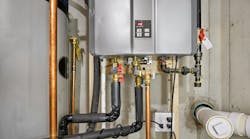Latest from Hydronics
Sponsored
Tankless Water Heater Market Size is Projected to Reach $6.84 Billion by 2030
NEW YORK, NY — (GLOBE NEWSWIRE) — The tankless water heater market is projected to reach $6.84 billion by 2030—growing at a CAGR of 7.45%—according to data collected and analyzed by Straits Research
Tankless water heaters are a cost-efficient alternative to conventional water heater tanks, in addition to being more energy-efficient than traditional water heater tanks. Tankless water heaters, also called instant, constant flow, tank-less, direct-vent, or flash hot water heaters, are appliances that do not store any water in internal tanks but instead heat large volumes of water quickly by conduction from a supply source.
Rapid Urbanization
Rapid urbanisation is a phenomenon that is shared by both industrialized and emerging nations. The United Nations (UN) projects that by the year 2050, around 68 percent of the world's population would reside in urban regions, which is an increase from the current percentage of 55 percent in 2018. In 1950, there were 751 million people living in urban areas, but in 2018, there were around 4.2 billion people living in urban areas, according to the same source. As a direct consequence of this, there has been an uptick in requests for tankless water heaters.
Demand for Energy-Efficiency
The demand for water heaters that are energy-efficient among consumers in industrialised nations is growing. Leading players in the market (including Rheem Manufacturing Company, Rinnai Corporation, A. O. Smith, Noritz America Corp., Ariston Thermo Group, Kyungdong Navien Co., Ltd., Stiebel Eltron GmbH & Co. KG, Bradford White Corp., Haier Electronics Group Co., Ltd., and Bajaj Electricals Ltd.) are concentrating their efforts on the introduction of energy-efficient products that can reduce monthly energy costs. As a result, the expansion of the worldwide tankless water heater market would be fuelled by these factors during the projected period.
Electrification
In the market for tankless water heaters throughout the world, electric heaters are seeing a significant uptick in demand. This is as a result of the fact that they are simple to set up and call for a reduced number of maintenance procedures. Additionally, electric devices have a long lifespan and have low ongoing maintenance and replacement expenses. In addition, the cutting-edge design of these heaters makes it possible to put them in confined spaces while at the same time eliminating the need for ventilation. This is in contrast to the design of gas water heaters.
Replacement Market
Over the course of the projected period, it is predicted that rising rates of replacement of conventional water heaters with tankless water heaters would present enormous opportunities. Old water heaters are being phased out in favour of tankless models thanks to financial incentives provided by the government in the form of rebates and subsidies, as well as a shift in customers' attitudes.
Ease of Installation, Operation
The expansion of the market is anticipated to be propelled during the projected period by the increasing demand for hybrid tankless water heaters that are simple in both their operation and their installation. In addition, the incorporation of regular features found on traditional water heaters into energy-efficient and cost-effective tankless water heaters is anticipated to create enormous development prospects for both the client and the producer.
Regional Overview
As a result of increased manufacturing adoption and a movement in customer demand, Europe maintained the largest market share in 2018. In addition, a growing demand from commercial establishments such as restaurants, hotels, and hospitals is anticipated to have a beneficial influence on the expansion of the market.
From 2019 to 2025, it is predicted that growth in North America will occur at a CAGR that is the highest, at 10.7 percent. Over the course of the projection period, one of the most important factors that will be driving demand for tankless water heaters is an increased awareness connected to ecological products, together with an increase in product visibility.
Key Highlights
- The tankless water heater market size was valued at $3.58 billion in 2021; it is estimated to reach $6.84 billion by 2030 and expand at a CAGR of 7.45% over the forecast period.
- Rapid urbanization is anticipated to fuel market expansion for tankless water heaters worldwide.
- A rising demand for energy-efficient water heaters is anticipated to drive the growth of the worldwide tankless water heater market.
- The rising use of tankless water heaters to replace older water heaters is driving the market.
- An increase in the demand for hybrid tankless water heaters with simple installation and operation will give opportunity for expansion to the market.
- In 2018, electric heaters held the largest market share, and it is projected that this segment would have the most rapid expansion in the years to come.
- In 2018, the residential application market had the dominant share of 72.4% of the overall market.
- From 2019 to 2025, the market for commercial applications will rise at a compound annual growth rate (CAGR) of 7.8 percent.
- As a result of increased manufacturing adoption and a movement in customer demand toward more energy efficient and cost-effective products, Europe maintained the largest market share in 2018.
Download Free Sample Report PDF by visiting https://straitsresearch.com/report/tankless-water-heater-market/request-sample


